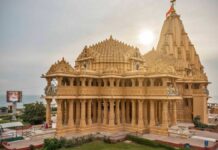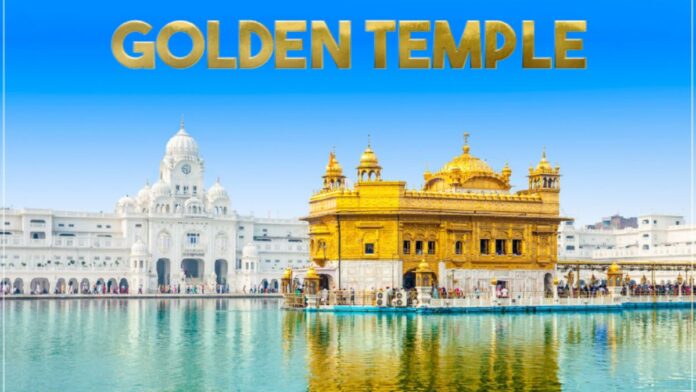The Golden Temple: A Glorious Symbol of Peace, Unity, and Spiritual Splendor
Introduction
The Golden Temple, also known as Harmandir Sahib, is a revered spiritual and cultural landmark located in the city of Amritsar, Punjab, India. Standing majestically in the middle of a serene pool of water known as the Amrit Sarovar, it holds immense significance for the Sikh community and attracts millions of visitors from around the world. With its breathtaking architecture, gleaming golden façade, and profound sense of spirituality, the Golden Temple is much more than just a religious monument—it is a symbol of peace, unity, and humanistic values that have inspired countless souls over the centuries.
Historical Background
The history of the Golden Temple dates back to the 16th century when the Sikh faith was founded by Guru Nanak Dev Ji. The first foundation stone of the temple was laid by Guru Arjan Dev Ji, the fifth Guru of Sikhism, in 1588. The temple was designed to be a place of worship and inclusivity, welcoming people of all faiths and backgrounds, reflecting the core values of Sikhism.
Architectural Marvel
The architecture of the Golden Temple is a fusion of Islamic and Hindu styles, symbolizing the unity of different cultures and religions. The main structure of the temple is built on a square platform with four entrances, symbolizing the acceptance and openness of Sikhism to all four corners of the world. The exquisite marble work and intricate details of the temple’s design leave visitors awe-inspired.
The most distinctive feature of the Golden Temple is its golden dome, covered with over 750 kilograms of pure gold, giving the temple its iconic appearance. The gold-covered exterior not only adds to the temple’s beauty but also serves as a metaphor for the radiant and divine nature of spirituality.
Surrounding the main temple is the Amrit Sarovar, a sacred water tank. Devotees believe that taking a dip in the Amrit Sarovar purifies their souls and grants blessings. The peaceful ambience created by the shimmering water and the soulful chanting of the Sikh hymns (Gurbani) makes it a place of solace and tranquility.
Harmandir Sahib as a Spiritual Center
The Golden Temple is not just a physical structure; it represents a spiritual center that fosters unity, compassion, and service to others. Sikhs believe in the concept of “sewa,” which translates to selfless service, and the temple is a prime example of this ideology. It operates the largest community kitchen in the world, known as the “Langar,” where volunteers serve free meals to all visitors, irrespective of their caste, creed, or social status. This tradition of communal dining reinforces the principles of equality and humanitarianism.
The Sikh scripture, Guru Granth Sahib, is placed inside the Golden Temple, and it serves as the eternal Guru and spiritual guide for the Sikh community. The hymns and teachings within the scripture emphasize love, equality, and the pursuit of truth, fostering a sense of harmony among all individuals.
Harmandir Sahib also plays a significant role in various Sikh festivals, with grand celebrations held during major occasions such as Guru Nanak Gurpurab, Baisakhi, and Diwali. These festivities not only attract Sikh pilgrims but also tourists and visitors from diverse backgrounds who wish to experience the vibrant and joyous atmosphere.
The Spirit of Inclusivity
The Golden Temple exemplifies the spirit of inclusivity and unity, transcending cultural and religious barriers. The temple’s open-door policy symbolizes that all are welcome, regardless of their beliefs or affiliations. It promotes the idea of “Ik Onkar,” meaning “One God,” which highlights the oneness of the divine and emphasizes that all human beings are interconnected.
Visitors to the temple often remark on the atmosphere of camaraderie and goodwill, where people from various walks of life come together in harmony, sharing meals and engaging in conversations. The Golden Temple serves as a testament to the fact that mutual respect and understanding can bridge gaps and bring people closer.
Historical Significance and Turbulent Times
Throughout its history, the Golden Temple has endured its share of challenges. In 1762, the Afghan invader Ahmad Shah Durrani attacked the temple and caused significant damage, including the theft of the gold and jewels adorning the structure. Later, during the British rule in India, the temple became a focal point for the struggle for independence, and it witnessed significant political movements led by Sikh leaders.
One of the darkest chapters in the temple’s history occurred during Operation Blue Star in June 1984. The Indian government launched a military operation to remove armed militants who had taken refuge inside the temple complex. The operation resulted in substantial damage to the temple, and it also led to the loss of many innocent lives. This incident deeply affected the Sikh community and left a lasting impact on the nation.
Despite the challenges and tragedies it has faced, the Golden Temple has continued to stand tall, symbolizing resilience, strength, and the unyielding spirit of the Sikh community.
Promoting Interfaith Dialogue
The Golden Temple has become a global symbol for interfaith dialogue and understanding. People from various faiths visit the temple not only to appreciate its architectural brilliance but also to gain insights into the teachings of Sikhism. Interacting with the Sikh community and experiencing the atmosphere of inclusivity helps foster a greater sense of tolerance and respect for diversity.
The temple has been a venue for various interfaith events and discussions, where scholars, religious leaders, and people from different backgrounds come together to promote mutual understanding and harmony. It serves as a beacon of hope for a world where people can coexist, appreciating and celebrating their differences.
Tourism and Cultural Heritage
The Golden Temple attracts millions of visitors from India and abroad every year, making it one of the most visited religious sites in the world. Its cultural significance and architectural grandeur make it a must-visit destination for tourists, history enthusiasts, and spiritual seekers alike.
The management of the temple has adopted modern technologies and practices to facilitate the smooth flow of visitors while preserving its sanctity. The temple complex provides free lodging facilities for pilgrims, ensuring that they can stay and immerse themselves in the spiritual ambiance.
Conclusion
The Golden Temple, or Harmandir Sahib, stands not only as a remarkable architectural marvel but also as an embodiment of the profound spiritual principles and humanitarian values that Sikhism represents. With its shimmering gold, tranquil waters, and the divine presence of the Guru Granth Sahib, the temple captivates the hearts of all who visit.
More than just a place of worship, the Golden Temple represents a timeless message of peace, unity, and inclusivity. It continues to inspire people worldwide to embrace love, compassion, and selfless service. As a symbol of resilience and cultural heritage, the Golden Temple will undoubtedly continue to shine its light on the path of humanity for generations to come.
Read Also : https://khabartez.com/2023/06/23/ramdev-baba-mandir-a-spiritual-haven-embracing-tradition-and-devotion/
Read Also : https://khabartez.com/2023/06/23/exploring-the-divine-abode-the-enchanting-khatu-shyam-baba-mandir/
Read Also : https://khabartez.com/2023/06/16/understanding-youtubes-new-guidelines/
Read Also : https://khabartez.com/2023/06/15/gujarat-cyclone-understanding-the-impact-and-preparedness-measures/
Read Also : https://khabartez.com/2023/06/02/a-sneak-peek-into-riva-solanki-life/
Read Also : https://khabartez.com/2023/06/02/the-seven-wonders-of-the-world/
Read Also : https://khabartez.com/2023/06/02/jaipur-city-history-a-journey-through-time/
Read Also : https://khabartez.com/2023/06/02/mr-narendra-modi-the-dynamic-leader-shaping-indias-destiny/
Read Also : https://khabartez.com/2023/05/30/top-10-trees-in-the-world/


































